Sake
Sake, also spelled saké (/ˈsɑːki, ˈsækeɪ/ SAH-kee, SAK-ay,[1][2] also referred to as Japanese rice wine),[3] is an alcoholic beverage made by fermenting rice that has been polished to remove the bran. Despite the name, unlike wine, in which alcohol is produced by fermenting sugar that is naturally present in fruit (typically grapes), sake, and indeed any East Asian rice wine, is produced by a brewing process more akin to that of beer, where starch is converted into sugars which ferment into alcohol.
_with_Children_-_Walters_49966_-_View_C.jpg) Sake bottle, Japan, c. 1740 | |
| Type | Alcoholic beverage |
|---|---|
| Country of origin | Japan |
| Alcohol by volume | 18–20% |
| Ingredients | Rice, water, kōji-kin |
.jpg)
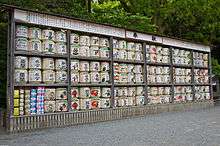
The brewing process for sake differs from the process for beer, where the conversion from starch to sugar and then from sugar to alcohol occurs in two distinct steps. Like other rice wines, when sake is brewed, these conversions occur simultaneously. The alcohol content differs between sake, wine, and beer; while most beer contains 3–9% ABV, wine generally contains 9–16% ABV,[4] and undiluted sake contains 18–20% ABV (although this is often lowered to about 15% by diluting with water prior to bottling).
In Japanese, the character sake (kanji: 酒, Japanese pronunciation: [sake]) can refer to any alcoholic drink, while the beverage called "sake" in English is usually termed nihonshu (日本酒; meaning 'Japanese wine'). Under Japanese liquor laws, sake is labelled with the word "seishu" (清酒; 'clear wine'), a synonym not commonly used in conversation.
In Japan, where it is the national beverage, sake is often served with special ceremony, where it is gently warmed in a small earthenware or porcelain bottle and sipped from a small porcelain cup called a sakazuki. As with wine, the recommended serving temperature of sake varies greatly by type.
History
The origin of sake is unclear. The earliest reference to the use of alcohol in Japan is recorded in the Book of Wei in the Records of the Three Kingdoms. This 3rd-century Chinese text speaks of the Japanese drinking and dancing.[5] Alcoholic beverages (Japanese: 酒, romanized: sake) are mentioned several times in the Kojiki, Japan's first written history, which was compiled in 712. Bamforth (2005) places the probable origin of true sake (which is made from rice, water, and kōji mold (麹, Aspergillus oryzae) in the Nara period (710–794). In the Heian period, sake was used for religious ceremonies, court festivals, and drinking games.[6] Sake production was a government monopoly for a long time, but in the 10th century, temples and shrines began to brew sake, and they became the main centers of production for the next 500 years. The Tamon-in Diary, written by abbots of Tamon-in (temple) from 1478 to 1618, records many details of brewing in the temple. The diary shows that pasteurization and the process of adding ingredients to the main fermentation mash in three stages were established practices by that time. In the 16th century, the technique of distillation was introduced into the Kyushu district from Ryukyu.[5] The brewing of shōchū, called "Imo–sake" started, and was sold at the central market in Kyoto.

In the 18th century, Engelbert Kaempfer[7] and Isaac Titsingh[8] published accounts identifying sake as a popular alcoholic beverage in Japan; but Titsingh was the first to try to explain and describe the process of sake brewing. The work of both writers was widely disseminated throughout Europe at the beginning of the 19th century.[9]
During the Meiji Restoration, laws were written that allowed anybody with the money and know-how to construct and operate their own sake breweries. Around 30,000 breweries sprang up around the country within a year. As time passed, the government levied increasing taxes on the sake industry and the number of breweries dwindled to 8,000.
Most of the breweries that grew and survived this period were established by wealthy landowners. Landowners who grew rice crops would have surplus rice at the end of the season. Rather than letting these leftovers go to waste, they shipped it to their breweries. The most successful of these family breweries still operate today.
During the 20th century, sake-brewing technology advanced. The government opened the sake-brewing research institute in 1904, and in 1907 the first government-run sake-tasting competition was held. Yeast strains specifically selected for their brewing properties were isolated and enamel-coated steel tanks arrived. The government started hailing the use of enamel tanks as easy to clean, lasting forever, and being devoid of bacterial problems. (The government considered wooden barrels to be unhygienic because of the potential bacteria living in the wood.) Although these things are true, the government also wanted more tax money from breweries, as using wooden barrels means that a significant amount of sake is lost to evaporation (approximately 3%), which could have otherwise been taxed. This was the end of the wooden-barrel age of sake and the use of wooden barrels in brewing was completely eliminated.
In Japan, sake has long been taxed by the national government. In 1898, this tax brought in about ¥5 million out of a total of about ¥120 million, about 4.6% of the government's total direct tax income.[10]
During the Russo-Japanese War in 1904–1905, the government banned the home brewing of sake. At the time, sake comprised 30% of Japan's tax revenue. Since home-brewed sake is tax-free, the logic was that by banning the home brewing of sake, sales would increase, and more tax revenue would be collected. This was the end of home-brewed sake, and the law remains in effect today even though sake sales now contribute only 2% of government income.
When World War II brought rice shortages, the sake-brewing industry was hampered as the government discouraged the use of rice for brewing. As early as the late 17th century, it had been discovered that small amounts of alcohol could be added to sake before pressing to extract aromas and flavors from the rice solids. During the war, pure alcohol and glucose were added to small quantities of rice mash, increasing the yield by as much as four times. 75% of today's sake is made using this technique. There were a few breweries producing "sake" that contained no rice at all. The quality of sake during this time varied greatly.
Postwar, breweries slowly recovered, and the quality of sake gradually increased. New players on the scene—beer, wine, and spirits—became popular in Japan, and in the 1960s beer consumption surpassed sake for the first time. Sake consumption continued to decrease while the quality of sake steadily improved.
Today, sake has become a world beverage with a few breweries in China, Southeast Asia, South America, North America, and Australia.[11] More breweries are also turning to older methods of production.
While the rest of the world may be drinking more sake and the quality of sake has been increasing, sake production in Japan has been declining since the mid-1970s.[12] The number of sake breweries is also declining. While there were 3,229 breweries nationwide in fiscal 1975, the number had fallen to 1,845 in 2007.[13]
Oldest sake brewery
The oldest known sake brewery is from the 15th century near an area that was owned by Tenryū-ji, in Ukyō-ku, Kyoto. Unrefined sake was squeezed out at the brewery and there are about 180 holes (60 cm wide, 20 cm deep) for holding storage jars. A hollow (1.8 meter wide, 1 meter deep) for a pot to collect drops of pressed sake and 14th-century Bizen ware jars were also found. It is estimated to be utilized until the Onin War (1467–1477). Sake was brewed at Tenryū-ji during the Muromachi Period (1336–1573).[14]
Production
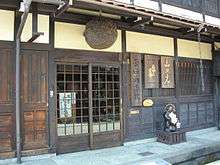
Rice
The rice used for brewing sake is called saka mai 酒米 (sake rice), or officially shuzō kōtekimai 酒造好適米 (sake-brewing suitable rice). There are at least 80 types of sake rice in Japan. Among these, Yamadanishiki, Gohyakumangoku, Miyamanishiki and Omachi rice are popular. The grain is larger, stronger (if a grain is small or weak, it will break in the process of polishing), and contains less protein and lipid than ordinary table rice. Sake rice is used only for making sake, because some say it is unpalatable for eating.
Sake rice is usually polished to a much higher degree than rice that is used as food. The reason for polishing is a result of the composition and structure of the rice grain itself. The core of the rice grain is rich in starch, while the outer layers of the grain contain higher concentrations of fats, vitamins and proteins. Since higher concentration of fat and protein in the sake would lead to off-flavors and contribute rough elements to the sake, the outer layers of the sake rice grain is milled away in a polishing process, leaving only the starchy part of the grain (some sake brewers remove over 60% of the rice grain in the polishing process). That desirable pocket of starch in the center of the grain is called the shinpaku (心白). It usually takes two to three days to polish rice down to less than half its original size. The rice powder by-product of polishing is often used for making rice crackers, or Japanese sweets (i.e. Dango), and other food stuffs.
If the sake is made with rice that has a higher percentage of its husk and outer portion of the core milled off, then more rice will be required to make that particular sake, and it will take longer to produce. Thus, sake made with rice that has been highly milled is usually more expensive than a sake that has been made with less-polished rice. This does not always mean that sake made with highly-milled rice is of better quality than sake made by rice that has been milled less.
Rice polishing ratio, called Seimai-buai 精米歩合 (see Glossary of sake terms) measures the degree of rice polishing. For example, rice polishing ratio of 60% means that the 60% of the original rice grain remains and the 40% has been polished away.
Water
Water is one of the important ingredients for making sake. It is involved in almost every major process of sake brewing, from washing the rice to dilution of the final product before bottling. The mineral content of the water can be important in the final product. Iron will bond with an amino acid produced by the kōji to produce off flavors and a yellowish color. Manganese, when exposed to ultraviolet light, will also contribute to discoloration. Conversely potassium, magnesium, and phosphoric acid serve as nutrients for yeast during fermentation and are considered desirable.[15] The yeast will use those nutrients to work faster and multiply resulting in more sugar being converted into alcohol. While soft water will typically yield sweeter sake, hard water with a higher nutrient content is known for producing drier-style sake.
The first region known for having great water was the Nada-Gogō in Hyōgo Prefecture. A particular water source called "Miyamizu" was found to produce high quality sake and attracted many producers to the region. Today Hyōgo has the most sake brewers of any prefecture.[15]
Typically breweries obtain water from wells, though surface water can be used. Breweries may use tap water and filter and adjust components.[15]
Kōji-kin
Kōji-kin (Aspergillus oryzae) spores are another important component of sake. Kōji-kin is an enzyme-secreting fungus.[16] In Japan, kōji-kin is used to make various fermented foods, including miso (a paste made from soybeans) and shoyu (soy sauce).[16] It is also used to make alcoholic beverages, notably sake.[16] During sake brewing, spores of kōji-kin are scattered over steamed rice to produce kōji (rice in which kōji-kin spores are cultivated).[17] Under warm and moist conditions, the kōji-kin spores germinate and release enzymes called amylases that convert the rice starches into glucose.[18] This process of starch conversion into simpler sugars (e.g. glucose or maltose) is called saccharification.[19] Yeast then turns this glucose into alcohol via fermentation.[17] Saccharification also occurs in beer brewing, where malt is used to convert starches from barley into maltose.[17] However, whereas fermentation occurs after saccharification in beer brewing, saccharification (via kōji-kin) and fermentation (via yeast) occur simultaneously in sake brewing (see "Fermentation" below).[17]
As kōji-kin is a microorganism used to manufacture food, its safety profile with respect to humans and the environment in sake brewing and other food-making processes must be considered. Various health authorities, including Health Canada and the U.S. Food and Drug Administration (FDA), consider kōji-kin (A. oryzae) generally safe for use in food fermentation, including sake brewing.[16] When assessing its safety, it is important to note that A. oryzae lacks the ability to produce toxins, unlike the closely related Aspergillus flavus.[16] To date, there have been several reported cases of animals (e.g. parrots, a horse) being infected with A. oryzae.[20] In these cases the animals infected with A. oryzae were already weakened due to predisposing conditions such as recent injury, illness or stress, hence were susceptible to infections in general.[20] Aside from these cases, there is no evidence to indicate A. oryzae is a harmful pathogen to either plants or animals in the scientific literature.[20] Therefore, Health Canada considers A. oryzae “unlikely to be a serious hazard to livestock or to other organisms,” including "healthy or debilitated humans."[20] Given its safety record in the scientific literature and extensive history of safe use (spanning several hundred years) in the Japanese food industry, the FDA and World Health Organization (WHO) also support the safety of A. oryzae for use in the production of foods like sake.[16] In the US, the FDA classifies A.oryzae as a Generally Recognized as Safe (GRAS) organism.[16]
Fermentation
Sake fermentation is a 3-step process called sandan shikomi.[21] The first step, called hatsuzoe, involves steamed rice, water, and kōji-kin being added to the yeast starter called shubo: a mixture of steamed rice, water, kōji, and yeast.[21] This mixture becomes known as the moromi (the main mash during sake fermentation).[21] The high yeast content of the shubo promotes the fermentation of the moromi.[21]
On the second day, the mixture is allowed to stand for a day to allow the yeast to multiply.[21]
The second step (the third day of the process), called nakazoe, involves the addition of a second batch of kōji, steamed rice, and water to the mixture.[21] On the fourth day of the fermentation, the third step of the process, called tomezoe, takes place.[21] Here, the third and final batch of kōji, steamed rice, and water is added to the mixture to complete the 3-step process.[21]
The fermentation process of sake is a multiple parallel fermentation, which is unique to sake.[21] Multiple parallel fermentation is the conversion of starch into glucose followed by immediate conversion into alcohol.[22] This process distinguishes sake from other liquors like beer because it occurs in a single vat, whereas with beer, for instance, starch to glucose conversion and glucose to alcohol conversion occur in separate vats.[22] The breakdown of starch into glucose is caused by the kōji-kin fungus, while the conversion of glucose into alcohol is caused by yeast.[22] Due to the yeast being available as soon as the glucose is produced, the conversion of glucose to alcohol is very efficient in sake brewing.[22] This results in sake having a generally higher alcohol content than other types of liquor.[22]
After the fermentation process is complete, the fermented moromi is pressed to remove the sake lees and then pasteurized and filtered for color.[21] The sake is then stored in bottles under cold conditions (see "Maturation" below).[21]
The entire process of making sake can range from 60–90 days (2–3 months), while the fermentation alone can take two weeks.[23]
Maturation
Like other brewed beverages, sake tends to benefit from a period of storage. Nine to twelve months are required for sake to mature. Maturation is caused by physical and chemical factors such as oxygen supply, the broad application of external heat, nitrogen oxides, aldehydes and amino acids, among other unknown factors.[24]
Tōji
Tōji (杜氏) is the job title of the sake brewer, named after Du Kang. It is a highly respected job in the Japanese society, with tōji being regarded like musicians or painters. The title of tōji was historically passed from father to son. Today new tōji are either veteran brewery workers or are trained at universities. While modern breweries with cooling tanks operate year-round, most old-fashioned sake breweries are seasonal, operating only in the cool winter months. During the summer and fall most tōji work elsewhere, commonly on farms, only periodically returning to the brewery to supervise storage conditions or bottling operations.[25]
Varieties
Special-designation sake
There are two basic types of sake: Futsū-shu (普通酒, ordinary sake) and Tokutei meishō-shu (特定名称酒, special-designation sake). Futsū-shu is the equivalent of table wine and accounts for the majority of sake produced. Tokutei meishō-shu refers to premium sake distinguished by the degree to which the rice has been polished and the added percentage of brewer's alcohol or the absence of such additives. There are eight varieties of special-designation sake.[26]
The four main grades of sake are junmai, honjozo, ginjo and daiginjo. Generally junmai (純米) is a term used for sake that is made of pure rice wine without any additional alcohol.[27] The listing below has the highest quality at the top:
| Special Designation | Ingredients | Rice Polishing Ratio (percent rice remaining) | Percentage of Kōji rice |
|---|---|---|---|
| Junmai Daiginjō-shu (純米大吟醸酒, Pure rice, Very Special brew) | Rice, Kōji rice | 50% or less | At least 15% |
| Daiginjō-shu (大吟醸酒, Very Special brew) | Rice, Kōji rice, Distilled alcohol[note 1] | 50% or less | At least 15% |
| Junmai Ginjō-shu (純米吟醸酒, Pure rice, Special brew) | Rice, Kōji rice | 60% or less | At least 15% |
| Ginjō-shu (吟醸酒, Special brew) | Rice, Kōji rice, Distilled alcohol[note 1] | 60% or less | At least 15% |
| Tokubetsu Junmai-shu (特別純米酒, Special Pure rice) | Rice, Kōji rice | 60% or less, or produced by special brewing method | At least 15% |
| Tokubetsu Honjōzō-shu (特別本醸造酒, Special Genuine brew) | Rice, Kōji rice, Distilled alcohol[note 1] | 70% or less, or produced by special brewing method | At least 15% |
| Junmai-shu (純米酒, Pure rice) | Rice, Kōji rice | Regulations do not stipulate a rice polishing ratio[28] | At least 15% |
| Honjōzō-shu (本醸造酒, Genuine brew) | Rice, Kōji rice, Distilled alcohol[note 1] | 70% or less | At least 15% |
- The weight of added alcohol must be below 10% of the weight of the rice (after polishing) used in the brewing process.
Ways to make the starter mash
- Kimoto (生酛) is the traditional orthodox method for preparing the starter mash, which includes the laborious process of using poles to mix it into a paste, known as yama-oroshi. This method was the standard for 300 years, but it is rare today.
- Yamahai (山廃) is a simplified version of the kimoto method, introduced in the early 1900s. Yamahai skips the step of making a paste out of the starter mash. That step of the kimoto method is known as yama-oroshi, and the full name for yamahai is “yama-oroshi haishi” (山卸廃止), meaning “discontinuation of yama-oroshi.” While the yamahai method was originally developed to speed production time compared to the kimoto method, it is slower than the modern method and is now used only in specialty brews for the earthy flavors it produces.
- Sokujō (速醸), "quick fermentation", is the modern method of preparing the starter mash. Lactic acid, produced naturally in the two slower traditional methods, is added to the starter to inhibit unwanted bacteria. Sokujō sake tends to have a lighter flavor than kimoto or yamahai.
Different handling after fermentation
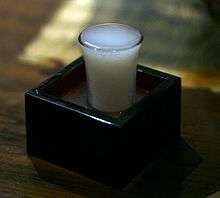
- Namazake (生酒) is sake that has not been pasteurized. It requires refrigerated storage and has a shorter shelf-life than pasteurized sake.
- Genshu (原酒) is undiluted sake. Most sake is diluted with water after brewing to lower the alcohol content from 18–20% down to 14–16%, but genshu is not.
- Muroka (無濾過) means unfiltered. It refers to sake that has not been carbon filtered, but which has been pressed and separated from the lees, and thus is clear, not cloudy. Carbon filtration can remove desirable flavors and odors as well as bad ones, thus muroka sake has stronger flavors than filtered varieties.
- Nigorizake (濁り酒) is cloudy sake. The sake is passed through a loose mesh to separate it from the mash. It is not filtered thereafter and there is much rice sediment in the bottle. Before serving, the bottle is shaken to mix the sediment and turn the sake white or cloudy.
- Seishu (清酒), "clear/clean sake", is the Japanese legal definition of sake and refers to sake in which the solids have been strained out, leaving clear liquid. Thus nigorizake and doburoku (see below) are not seishu and therefore are not actually sake under Japanese law. Nigorizake can receive the seishu status by being strained clear and having the lees put back in afterward.
- Koshu (古酒) is "aged sake". Most sake does not age well, but this specially made type can age for decades, turning yellow and acquiring a honeyed flavor.
- Taruzake (樽酒) is sake aged in wooden barrels or bottled in wooden casks. The wood used is Cryptomeria (杉, sugi), which is also known as Japanese cedar. Sake casks are often tapped ceremonially for the opening of buildings, businesses, parties, etc. Because the wood imparts a strong flavor, premium sake is rarely used for this type.
- Shiboritate (搾立て), "freshly pressed", refers to sake that has been shipped without the traditional six-month aging/maturation period. The result is usually a more acidic, "greener" sake.
- Fukurozuri (袋吊り) is a method of separating sake from the lees without external pressure by hanging the mash in bags and allowing the liquid to drip out under its own weight. Sake produced this way is sometimes called shizukuzake (雫酒), meaning "drip sake".
- Tobingakoi (斗瓶囲い) is sake pressed into 18-liter (4.0 imp gal; 4.8 U.S. gal) bottles ("tobin") with the brewer selecting the best sake of the batch for shipping.
Others
- Amazake (甘酒) is a traditional sweet, low-alcoholic Japanese drink made from fermented rice.
- Doburoku (濁酒) is the classic home-brew style of sake (although home brewing is illegal in Japan). It is created by simply adding kōji mold to steamed rice and water and letting the mixture ferment. The resulting sake is somewhat like a chunkier version of nigorizake.
- Jizake (地酒) is locally brewed sake, the equivalent of microbrewing beer.
- Kuroshu (黒酒) is sake made from unpolished rice (i.e., brown rice), and is more like huangjiu.
- Teiseihaku-shu (低精白酒) is sake with a deliberately high rice-polishing ratio. It is generally held that the lower the rice polishing ratio (the percent weight after polishing), the better the potential of the sake. Circa 2005, teiseihaku-shu has been produced as a specialty sake made with high rice-polishing ratios, usually around 80%, to produce sake with the characteristic flavor of rice itself.
Some other terms commonly used in connection with sake:
- Nihonshu-do (日本酒度), also called the Sake Meter Value, or SMV
- Specific gravity is measured on a scale weighing the same volume of water at 4 °C (39 °F) and sake at 15 °C (59 °F). The sweeter the sake, the lower the number (or more negative) and the drier the sake, the higher the number. When the SMV was first used, 0 was designated the point between sweet sake and dry sake. Now +3 is considered neutral.
- Seimai-buai (精米歩合) is the rice polishing ratio (or milling rate), the percentage of weight remaining after polishing. Generally, the lower the number, the higher the sake's complexity. A lower percentage usually results in a fruitier and more complex sake, whereas a higher percentage will taste more like rice.
- Kasu (粕) are pressed sake lees, the solids left after pressing and filtering. These are used for making pickles, livestock feed, and shōchū, and as an ingredient in dishes like kasu soup.
Taste and flavor
The label on a bottle of sake gives a rough indication of its taste. Terms found on the label may include nihonshu-do (日本酒度), san-do (酸度), and aminosan-do (アミノ酸度).[29]
Nihonshu-do (日本酒度) or Sake Meter Value (SMV) is calculated from the specific gravity of the sake and indicates the sugar and alcohol content of the sake on an arbitrary scale. Typical values are between −3 (sweet) and +10 (dry), equivalent to specific gravities ranging between 1.007 and 0.998, though the maximum range of Nihonshu-do can go much beyond that. The Nihonshu-do must be considered together with San-do to determine the overall perception of dryness-sweetness, richness-lightness characteristics of a sake (for example, a higher level of acidity can make a sweet sake taste drier than it actually is).[30][31]
San-do (酸度) indicates the concentration of acid, which is determined by titration with sodium hydroxide solution. This number is equal to the milliliters of titrant required to neutralize the acid in 10 ml (0.35 imp fl oz; 0.34 US fl oz) of sake.
Aminosan-do (アミノ酸度) indicates a taste of umami or savoriness. As the proportion of amino acids rises, the sake tastes more savory. This number is determined by titration of the sake with a mixture of sodium hydroxide solution and formaldehyde, and is equal to the milliliters of titrant required to neutralize the amino acids in 10 ml of sake.
Sake can have many flavor notes, such as fruits, flowers, herbs, and spices. Many types of sake have notes of apple from ethyl caproate, and banana from isoamyl acetate, particularly ginjōshu (吟醸酒).
Serving sake
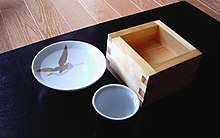
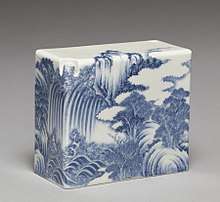
In Japan, sake is served chilled (reishu 冷酒), at room temperature (jōon 常温), or heated (atsukan 熱燗), depending on the preference of the drinker, the characteristics of the sake, and the season. Typically, hot sake is a winter drink, and high-grade sake is not usually drunk hot, because the flavors and aromas may be lost. Most lower-quality sake is served hot because that is the traditional way and it often tastes better that way, not so that flaws are covered up. There are gradations of temperature both for chilling and heating, about every 5 °C (9.0 °F), with hot sake generally served around 50 °C (122 °F), and chilled sake around 10 °C (50 °F), like white wine. Hot sake that has cooled (kanzamashi 燗冷まし) may be reheated.
Sake is traditionally drunk from small cups called choko or o-choko (お猪口) and poured into the choko from ceramic flasks called tokkuri. This is very common for hot sake, where the flask is heated in hot water and the small cups ensure that the sake does not get cold in the cup, but may also be used for chilled sake. Traditionally one does not pour one's own drink, which is known as tejaku (手酌), but instead members of a party pour for each other, which is known as shaku (酌). This has relaxed in recent years, but is generally observed on more formal occasions, such as business meals, and is still often observed for the first drink.
Another traditional cup is the masu, a box usually made of hinoki or sugi, which was originally used for measuring rice. The masu holds exactly 180 ml (6.3 imp fl oz; 6.1 US fl oz), so the sake is served by filling the masu to the brim; this is done for chilled or room temperature sake. In some Japanese restaurants, as a show of generosity, the server may put a glass inside the masu or put the masu on a saucer and pour until sake overflows and fills both containers.
Saucer-like cups called sakazuki are also used, most commonly at weddings and other ceremonial occasions, such as the start of the year or at the beginning of a kaiseki meal. In cheap bars, sake is often served room temperature in glass tumblers and called koppu-zake (コップ酒). In more modern restaurants wine glasses are also used, and recently footed glasses made specifically for premium sake have also come into use.
Sake is traditionally served in units of 180 ml (6.3 imp fl oz; 6.1 US fl oz) (one gō), and this is still common, but other sizes are sometimes also available.
Traditionally sake is heated immediately before serving, but today restaurants may buy sake in boxes which can be heated in a specialized hot sake dispenser, thus allowing hot sake to be served immediately, though this is detrimental to the flavor. There are also a variety of devices for heating sake and keeping it warm, beyond the traditional tokkuri.
Aside from being served straight, sake can be used as a mixer for cocktails, such as tamagozake, saketinis or nogasake.[32] Outside of Japan, the sake bomb, the origins of which are unclear,[33] has become a popular drink in bars and Asia-themed karaoke clubs.
The Japanese Sake Association encourages people to drink chaser water for their health, and the water is called Yawaragi-mizu.[34]
Seasonality
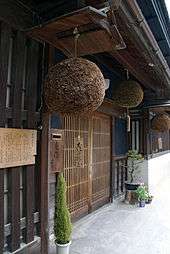
Traditionally sake was brewed only in the winter. While it can now be brewed year-round, there is still seasonality associated with sake, particularly artisanal ones. The most visible symbol of this is the sugitama (杉玉), a globe of cedar leaves traditionally hung outside a brewery when the new sake is brewed. The leaves start green, but turn brown over time, reflecting the maturation of the sake. These are now hung outside many restaurants serving sake. The new year's sake is called shinshu 新酒 ("new sake"), and when initially released in late winter or early spring, many brewers have a celebration, known as kurabiraki 蔵開き (warehouse opening). Traditionally sake was best transported in the cool spring, to avoid spoilage in the summer heat, with a secondary transport in autumn, once the weather had cooled, known as hiyaoroshi 冷卸し ("cold wholesale distribution")—this autumn sake has matured over the summer.
There is not traditionally a notion of vintage of sake—it is generally drunk within the year, and if aged, it does not vary significantly from year to year. Today, with influence from wine vintages, some breweries label sake intended for aging with a vintage, but this is otherwise rare.
Storage
Sake is sold in volume units divisible by 180 ml (6.3 imp fl oz; 6.1 US fl oz) (a gō), the traditional Japanese unit for cup size: sake is traditionally sold by the gō-sized cup, or in a 1.8 l (63 imp fl oz; 61 US fl oz) (one shō, ten gō) sized flask. Today sake is also often sold in 720 ml (25 imp fl oz; 24 US fl oz) (four gō) bottles – note that this is almost the same as the 750 ml (26 imp fl oz; 25 US fl oz) standard for wine bottles, but is divisible into 4 gō. Particularly in convenience stores, sake may be sold in a 180 ml (6.3 imp fl oz; 6.1 US fl oz) single serving glass with a pull-off top (カップ酒 kappu-zake) – this is generally cheap sake – or in a small 360 ml (13 imp fl oz; 12 US fl oz) bottle.
In general, it is best to keep sake refrigerated in a cool or dark room, as prolonged exposure to heat or direct light will lead to spoilage. Sake stored at relatively high temperature can lead to formation of dicetopiperazine, a cyclo (Pro-Leu) that makes it bitter as it ages [35] Sake has high microbiological stability due to its high content of ethanol, but incidences of spoilage have occurred. One of the microorganisms implicated in this spoilage is lactic acid bacteria (LAB) that has grown tolerant to ethanol and is referred to as hiochi-bacteria.[36] Sake stored at room temperature is best consumed within a few months after purchase.
After opening a bottle of sake, it is best consumed within two or three hours. It is possible to store sake in the refrigerator, but it is recommended to consume it within two days. When premium sake is opened it begins to oxidize, which affects the taste. If the sake is kept in the refrigerator more than three days, it will lose its "best" flavor. This does not mean it should be disposed of if not consumed. Generally, sake can keep very well and taste good after weeks in the refrigerator. How long a sake will remain drinkable depends on the quality of the product, and whether it is sealed with a vacuum top to decrease oxidation.
Ceremonial use
Sake is often consumed as part of Shinto purification rituals. Sake served to gods as offerings prior to drinking are called o-miki (御神酒) or miki (神酒).
In a ceremony called kagami biraki, wooden casks of sake are opened with mallets during Shinto festivals, weddings, store openings, sports and election victories, and other celebrations. This sake, called iwai-zake ("celebration sake"), is served freely to all to spread good fortune.
At the New Year many Japanese people drink a special sake called toso. Toso is a sort of iwai-zake made by soaking tososan, a Chinese powdered medicine, overnight in sake. Even children sip a portion. In some regions, the first sips of toso are taken in order of age, from the youngest to the eldest.
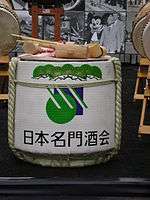 A cask of sake before the kagami biraki
A cask of sake before the kagami biraki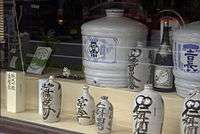 Decorative sake containers in a Nakatsugawa shop
Decorative sake containers in a Nakatsugawa shop
Events
- October 1 is the official "Sake Day" (日本酒の日, "Nihonshu no Hi") of Japan.[37] It is also called "World Sake Day". It was designated by the Japan Sake and Shochu Makers Association in 1978.
See also
- Amylolytic process
- Awamori, a distilled rice liquor produced in Okinawa
- The Birth of Saké
- Cheongju, a Korean equivalent
- Chuak, a Tripuri rice beer
- Glossary of sake terms
- Habushu, awamori liquor containing a snake
- Kohama style, a method of sake brewing
- Mijiu, a Chinese equivalent
- Mirin, an essential condiment used in Japanese cuisine, which has been drunk as a sweet sake
- Toso, spiced medicinal sake
References
- The American Heritage Dictionary of the English Language. Boston: Houghton Mifflin Harcourt. 2011. p. 1546. ISBN 978-0-547-04101-8.
- The Oxford Dictionary of Foreign Words and Phrases. Oxford: Oxford University Press. 1997. p. 375. ISBN 0-19-860236-7.
- "alcohol consumption". Encyclopedia Britannica. Retrieved March 9, 2017.
- Robinson, Jancis (2006). The Oxford Companion to Wine (3rd ed.). Oxford University Press. p. 10.
- "sake | alcoholic beverage". Encyclopedia Britannica. Retrieved March 9, 2017.
- Morris, Ivan (1964). The World of the Shining Prince: Court Life in Ancient Japan. New York: Knopf.
- Kaempfer, Engelbert (1906). The History of Japan. I. p. 187.
- Titsingh, Isaac. (1781). "Bereiding van de Sacki" ("Production of Sake"), Verhandelingen van het Bataviaasch Genootschap (Transactions of the Batavian Academy). Vol. III. OCLC 9752305
- Morewood, Samuel (1824). An Essay on the Inventions and Customs of Both Ancients and Moderns in the Use of Inebriating Liquors. Books on Demand. p. 136.
japan sacki.
- Casal, U. A. (1939). "Some notes on the Sakazuki and the Role of Drinking Sake in Japan". Transactions of the Asiatic Society of Japan: 73.
- Hirano, Ko (May 4, 2019). "American-based breweries are creating their own brand of sake". The Japan Times Online. ISSN 0447-5763. Retrieved December 4, 2019.
- Gauntner, John (2002). The Sake Handbook. p. 78. ISBN 9780804834254.
- Omura, Mika (November 6, 2009). "Weekend: Sake breweries go with the flow to survive". Retrieved December 29, 2009.
- "Oldest sake brewery found at former temple site in Kyoto". The Asahi Shimbun. Retrieved January 20, 2020.
- Gauntner, John. "How Sake Is Made". Sake World. Retrieved January 1, 2016.
- Machida, Masayuki; Yamada, Osamu; Gomi, Katsuya (August 2008). "Genomics of Aspergillus oryzae: Learning from the History of Koji Mold and Exploration of Its Future". DNA Research. 15 (4): 173–183. doi:10.1093/dnares/dsn020. ISSN 1340-2838. PMC 2575883. PMID 18820080.
- "How sake is made". Tengu Sake. Retrieved August 8, 2019.
- "Aspergillus oryzae – an overview". www.sciencedirect.com. Retrieved August 8, 2019.
- "Saccharification – an overview". www.sciencedirect.com. Retrieved August 8, 2019.
- Government of Canada, Public Services and Procurement Canada. "Information archivée dans le Web" (PDF). publications.gc.ca. Archived from the original (PDF) on June 27, 2018. Retrieved August 8, 2019.
- "Brewing Process | How to | Japan Sake and Shochu Makers Association". www.japansake.or.jp. Retrieved August 8, 2019.
- "Multiple parallel fermentation: Japanese Sake". en-tradition.com. Archived from the original on August 8, 2019. Retrieved August 8, 2019.
- Gauntner, John. "Sake brewing process". Sake World. Retrieved August 8, 2019.
- National Research Institute of Brewing (March 2017). "Sake Brewing: The Integration of Science and Technology" (PDF). The Story of Sake.
- "The People". eSake.
- "「清酒の製法品質表示基準」の概要" [Summary of Sake brewing quality labeling standard] (in Japanese). National Tax Agency Japan.
- Jennings, Holly (2012). Asian Cocktails: Creative Drinks Inspired by the East. ISBN 9781462905256.
- WSET Level 3 Award in Sake Study Guide
- Gauntner, John (March 1, 2002). "The Nihonshu-do; Acidity in Sake". Sake World. Archived from the original on March 25, 2014. Retrieved February 27, 2014.
- "What's Sake Meter Value (SMV)?". Ozeki Sake. Retrieved May 27, 2020.
- "Sake Taste and Sake Scale". sakeexpert.com. Retrieved May 27, 2020.
- Ume Cocktail Menu. Tucson, AZ: Ume Casino Del Sol, 2015. Print.
- "An Ode to the Sake Bomb". Los Angeles Magazine. April 22, 2013. Retrieved March 9, 2017.
- "Yawaragi". japansake.or.jp.
- (Lecture Note, Oct. 2011).
- (Suzuki et al., 2008).
- "10月1日の「日本酒の日」には確かな根拠あり". Sake Service Institute. Archived from the original on January 16, 2013. Retrieved December 16, 2012.
General sources
- Bamforth CW. (2005) "Sake". Food, Fermentation and Micro-organisms. Blackwell Science: Oxford, UK: 143–153.
- Kobayashi T, Abe K, Asai K, Gomi K, Uvvadi PR, Kato M, Kitamoto K, Takeuchi M, Machida M. (2007). "Genomics of Aspergillus oryzae". Biosci Biotechnol. Biochem. 71(3):646–670.
- Suzuki K, Asano S, Iijima K, Kitamoto K. (2008). "Sake and Beer Spoilage Lactic Acid Bacteria – A review". The Inst of Brew & Distilling; 114(3):209–223.
- Uno T, Itoh A, Miyamoto T, Kubo M, Kanamaru K, Yamagata H, Yasufuku Y, Imaishi H. (2009). "Ferulic Acid Production in the Brewing of Rice Wine (Sake)". J Inst Brew. 115(2):116–121.
Further reading
- Aoki, Rocky, Nobu Mitsuhisa and Pierre A. Lehu (2003). Sake: Water from Heaven. New York: Universe Publishing. ISBN 0-7893-0847-9, 978-0-7893-0847-4
- Bunting, Chris (2011). Drinking Japan. Singapore: Tuttle Publishing. ISBN 978-4-8053-1054-0.
- Eckhardt, Fred (1993). Sake (U.S.A.): A Complete Guide to American Sake, Sake Breweries and Homebrewed Sake. Portland, Oregon: Fred Eckhardt Communications. ISBN 0-9606302-8-7, 978-0-9606302-8-8.
- Gauntner, John (2002). The Sake Handbook. Tokyo: Tuttle Publishing. ISBN 0-8048-3425-3, 978-0-8048-3425-4.
- Harper, Philip; Haruo Matsuzaki; Mizuho Kuwata; Chris Pearce (2006). The Book of Sake: A Connoisseurs Guide. Tokyo: Kodansha International. ISBN 4-7700-2998-5, 978-4-7700-2998-0
- Kaempfer, Engelbert (1906). The History of Japan: Together with a Description of the Kingdom of Siam, 1690–92, Vol I. Vol II. Vol III. London: J. MacLehose and Sons. OCLC 5174460.
- Morewood, Samuel (1824). An Essay on the Inventions and Customs of Both Ancients and Moderns in the Use of Inebriating Liquors: Interspersed with Interesting Anecdotes, Illustrative of the Manners and Habits of the Principal Nations of the World, with an Historical View of the Extent and Practice of Distillation. London: Longman, Hurst, Rees, Orme, Brown, and Green. OCLC 213677222.
- Titsingh, Issac (1781). "Bereiding van de Sacki" ("Producing Sake"), Verhandelingen van het Bataviaasch Genootschap (Transactions of the Batavian Academy), Vol. III. OCLC 9752305.
External links
| Wikimedia Commons has media related to Sake. |
| Look up sake in Wiktionary, the free dictionary. |